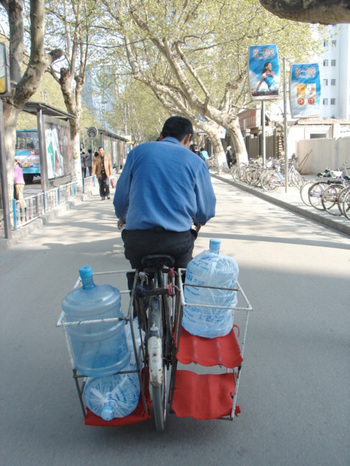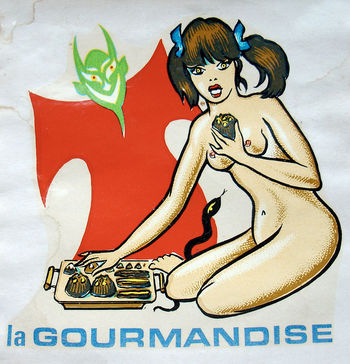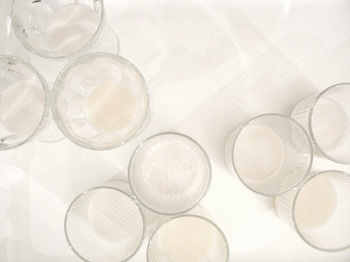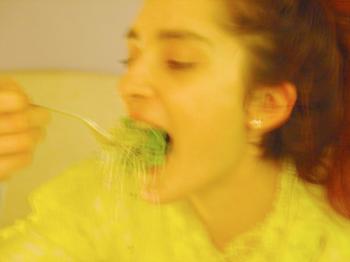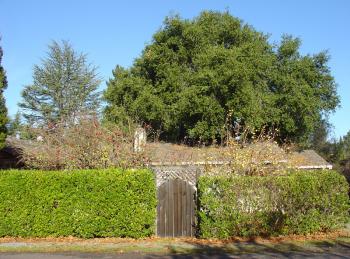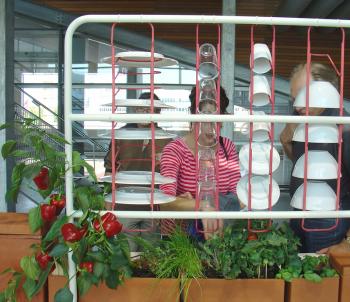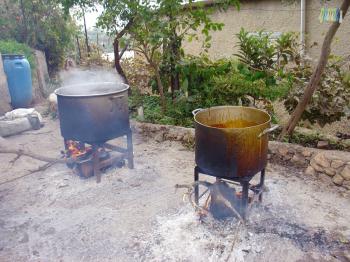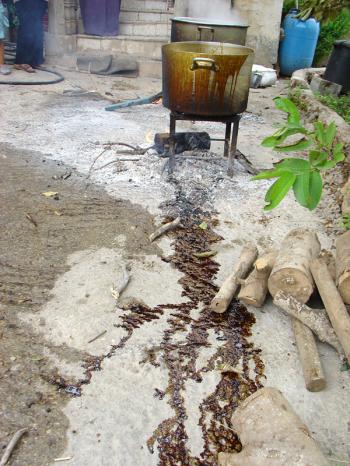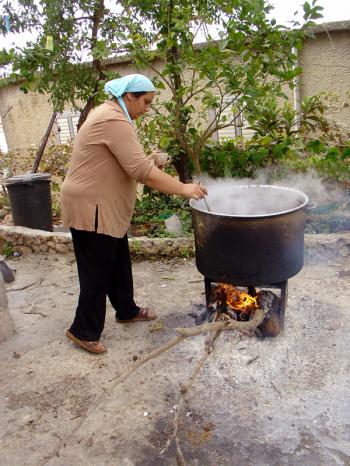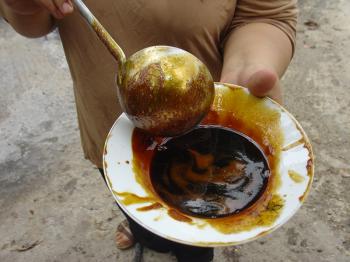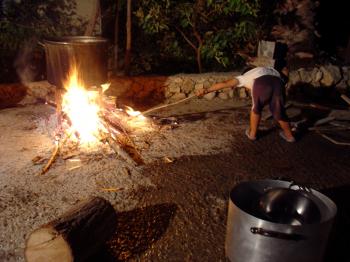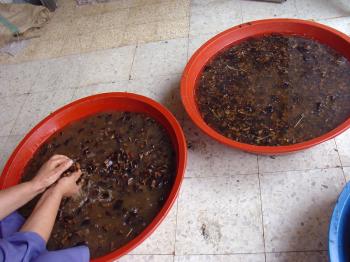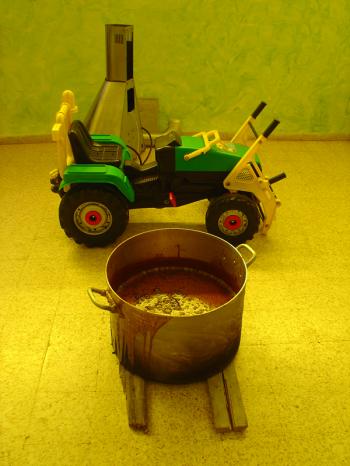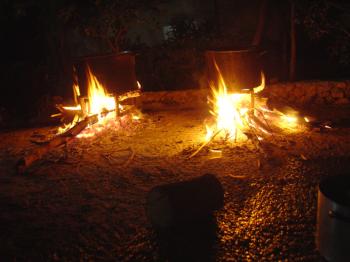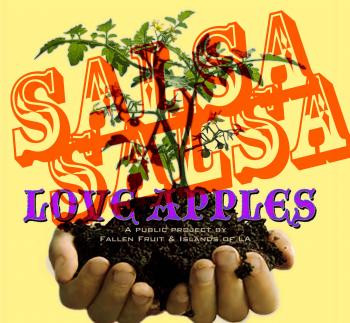Saosan’s carob syrup
August 26, 2008
A sloppy fig branch roadblock fuels fires burning purposefully under two steel pot stands, each supporting a blackened aluminium cauldron. You can feel the heat halfway down the street where unpredictable gusts of smoke inevitably find your eyes, turn your head for a breath of, oh the parfum of fig wood smoke. Please stay in my hair forever.
Inside the cauldrons a boiling coffee-coloured liquid moves Saosan and Kamili to swoop in with ladels to test its consistency. If you can get close, the smell of burnt sugar wins out over fig wood. Some protective gear would help against the heat, the ladies are all about layers. Saosan approaches with a sticky plate and dimples that ask me to taste. Molasses, carob, sticky, good. Not entirely my cup of tea, but I no sooner think this than a cup of carob tea is pressed into my hand.
Kids flit in and out, attracted by the activity, fiddle with Saosan’s efficient fires. The little boys at least are eventually shooed away by her shouts, go to start their own much bigger fires, considerably larger than they are. It’s all in good fun, the flames are massive but die down quickly, like the attention spans of the boys that make them. The boys are burning cardboard which would infuriate our Maurizio, if only he knew. 4 days now he’s been trying desperately to commandeer all of Ayn Hawd’s used cardboard for Yona’s installation.
Saosan and Kamili are making carob syrup or ‘rup’, from the carob they picked themselves, washed themselves, cut and soaked themselves. The entire house is involved, the entire street really, seeing as how it’s blocked off with big fig branches, hastily sawn, some not sawn just broken off. Spatially, temporily, apparently, this is the time of ‘rup’. Saosan is making a year’s worth, two days in, days and nights, really. One more day to go, and night.
debra at 10:47 | Comments (5) | post to del.icio.us
Soft landing in Ayn Hawd
August 23, 2008
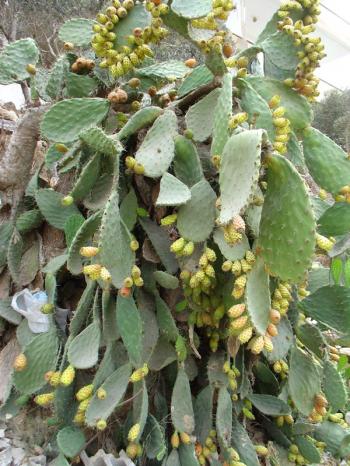
The tickly prickly pears of Ayn Hawd
Two days ago I arrived in Ayn Hawd, to start producing my farmer’s market installation for the One Land project and Platform Paradise exhibition. In 2004 the Palestinian village of Ayn Hawd received widespread recognition when architect Malkit Shoshan (NL/IL) initiated an international architecture competition to develop a forward-thinking masterplan for the village. An underlying notion behind the competition is the issue of Israeli zoning laws and planning practice used to express non-kosher political ideologies. From 1948 when the villagers were expelled from their ancestral location only a few kilometres away, to 2004 when Shoshan initiated the One Land (Two Systems) project, Ayn Hawd had been an illegal, non-existant village, situated in Israel, but subject to an entirely separate set of laws and lack of access to state infrastructure.
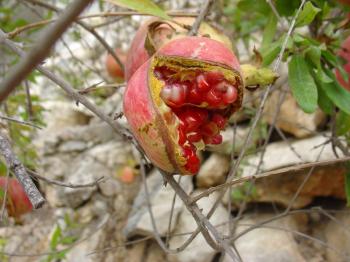
The exploding pomegranates of Ayn Hawd
Now Ayn Hawd is in a state of transformation, all the more so due to the effects of the exhibition and One Land project.
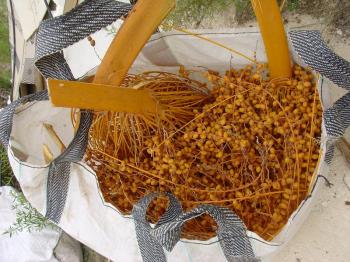
Yellow dates harvested in of Ayn Hawd
Collaborating with the villagers, my small part in this massive project is to develop a farmer’s market for Ayn Hawd, and I’ve been devoting the days to researching the village’s produce and taking stock of her food products. Olives, pomegranates, figs, kumquat, dates, grapes, prickly pears, passion fruit, peaches, lemons, limes, carob, plums, and pecans, but also herbs: thyme, hyssop, sages, rosemary, lavender, basil, chamomille, eucalyptus, lemongrass, and then there’s the honey, and the flowers, all the things one can make with all of the above ingredients. I’m certain I’ve ommitted more than half of the species, because I don’t recognise them, because I don’t know them, I can’t even see that they’re there.
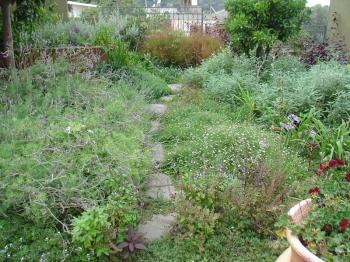
Herb garden at restaurant Al Beet in Ayn Hawd
It’s extraordinarily beautiful, with outstanding food and folk. The best restaurant in Israel is run by the mayor’s wife, Safiya and the family, right under the place where we are staying. Al Beet (the house/at home) has an herb garden and fruited terraces with figs and walls of passion fruit. Whoever is doing the landscaping clearly has a basil addiction, but the chammomile is also well represented and of course the ubiquitous thyme and hyssop… it all gets turned into za’atar.
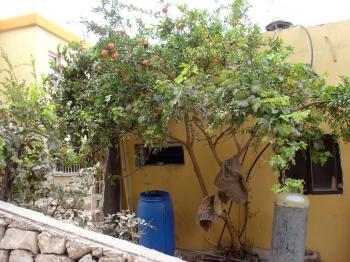
Pomegranate, grape, rose hips and kumquat in Ayn Hawd
One day in and they’re already overfeeding us, but that was to be expected.
-
PLATFORM PARADISE is an art show commissioned by FAST (Foundation for Achieving a Seamless Territory) and curated by Maurizio Bortolotti assisted by Noga Inbar, will open from September 1st to 7th, and continue until November 1st. Invited artists and architects will address the villageâs lack of public space (as an âunofficialâ place) by interacting with the villagers to improve their living conditions and generate new kinds of common ground. âPlatform Paradise is a democratic tool aimed at bringing art (projects) into a specific living space of a community. The lack of cultural institutions in Ayn Hawd creates a new condition in which art is represented and used. In this experimental space a new kind of art projects will emergeâ (Maurizio Bortolotti).
The artists will work in the village from 1st Septemebr- 6th September 2008
The opening of the art show: 6th September 2008
The show will be exhibited in Ayn Hawd until the 1st November 2008, some of the projects will remain in the village.
- MUSEO AEROSOLAR, a project initiated by Tomas Saraceno and Alberto Pesavento with communities in Abu Dhabi, Frankfurt am Main, Milan, Medellin (Colombia), Tirana, and now Ayn Hawd.
- TODAY, a video installation by Ali Kazma
- MERSTRUKTUREN by Yona Friedman
- THIRD LAND by Map Office
- A VIDEO INSTALLATION by Dan Graham
- UNTITLED by Nico Dockx and Helena Sidiropoulos
- THE ROAD MAP video installation by Stefano Boeri/Multiplicity
- MARKET DEVELOPMENT by Debra Solomon
- APPEARANCES by Berend Strik and Nisreen Abu Al Hayja with the Community of Ayn Hawd
Platform Paradise press release: low resolution (1.7 mb pdf)
Platform Paradise press release: high resolution (9 mb) pdf)
Restaurant Al Beet in Ayn Hawd, the best Palestinian food in Israel
Website devoted to providing the histories of the unrecognised Palestinian villages
Interesting website article about Israel’s unrecognised villages on Cult Case
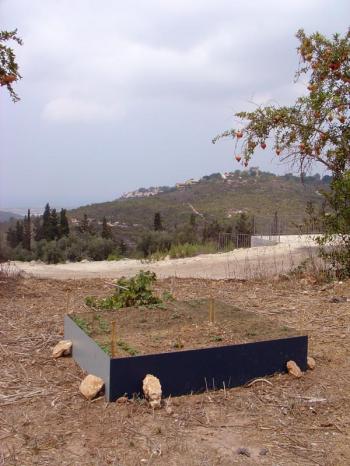
Map Office’s One Land garden installation in Ayn Hawd
debra at 14:36 | Comments (2) | post to del.icio.us
SALSA SALSA!
August 13, 2008
If you’re in or near Los Angeles this Sunday, may I suggest that you spend your entire allotted carbon footprint for the weekend on visiting the Fallen Fruit art collective’s summer harvest event SALSA SALSA. There you can make and taste tomato salsas while listening and dancing to salsa music. SALSA SALSA is a celebration of public space and the culmination of the LOVE APPLES project in which 72 tomato plants were installed on 12 traffic islands in LA and carefully tracked to see which thrive and which perish, Ă la Survivor.
LOVE APPLES is an experiment in public space in the city of Los Angeles, imagining new ways in which such spaces could be utilized to make our communities more livable and engaged. It promotes community awareness, sharing, food safety, public resources, and organic gardening. LOVE APPLES is a collaboration between the art collective Fallen Fruit and Islands of LA. The artists of Fallen Fruit investigate urban space, ideas of neighborhood and new forms of located citizenship and community all through the lens of fruit. Islands of LA is an art project that is turning traffic islands into territories of art to create community, foster discussion and explore the use and availability of public space.
PLEASE JOIN Fallen Fruit from 3 to 7 p.m. on Sunday August 17th at Farmlab (1745 N. Spring Street) to make salsa and dance together. There will be music from Mestizo L.A., a local salsa band, and a free Salsa dance class taught by Miguel Candela, a local Salsa teacher. Meet new people and talk about the future shape and texture of life in this city, including the artists and organizers listed above. Bring your homegrown or street-picked tomatoes (or chiles!) and collaborate with your neighbors on new and remarkable salsas. Bring a good food eating and dancing friend â this event is free to the public.
-
the Fallen Fruit artist collective is based in L.A.
Informative culiblog entry about the Fallen Fruit Collective
Fallen Fruit’s schedule of events
Another sort of Fallen Fruit, this time it’s by the ‘wayside’
And let us not forget the delicious joys of Stolen Fruit
In Istanbul, planting tomatoes and even entire gardens in the public domain is de rigeur
debra at 11:07 | Comments (1) | post to del.icio.us

